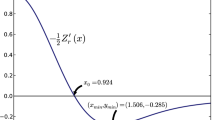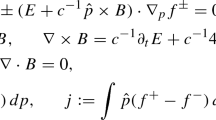Summary
A criterion for the development of electrostatic space-charge oscillations is investigated for a wide variety of physical systems involving plasmas. The instability associated with the occurrence of such plasma oscillations is characterized for typical solid-state plasmas in metals and semiconductors as well as for actual gaseous plasmas in the form of astrophysical bodies and laboratory gas discharges. The principal effort required for this sort of undertaking entails the evaluation of the carrier density and the dominant relaxation mechanism that control the onset of these oscillations. Thus, certain temperature functionals arise whose meaning must be appraised. The possibility of an optimal temperature range so emerges, providing a novel explanation of well-defined regions of a.c. output for plasma thermionic energy converters. The presence of spatial gradients in particle density and temperature in the interior of stars is shown to lead to a zonal instability,i.e., on passage outward from the thermonuclear core to the outer surface, the critical condition for the growth of plasma oscillations may be fulfilled over a limited region. The present-day conditions for laboratory thermonuclear plasmas turn out to be unstable; a closer look at high-density plasmas appears in order. Future refinement of the treatment of the relaxation processes may particularly take into account subtleties in the scattering of charged particles; the limiting behavior for Coulomb and screened potentials reveals essential differences. The well-known Onsager-Kirkwood criterion for ionized media may be viewed as a special case of the general criterion and is basically a stability criterion appropriate for plasmas where the relaxation derives from the screening of charges as in the Debye-Hückel theory. A number of other interesting items are briefly touched upon as the possible entry of the stability question in line-profile behaviour under the influence of local electrostatic fields.
Riassunto
Si studia un criterio per lo sviluppo delle oscillazioni elettrostatiche dello spazio delle cariche per un’ampia varietà di sistemi fisici, che interessano i plasmi. Si caratterizza l’instabilità associata al verificarsi di queste oscillazioni del plasma per i tipici plasma dello stato solido nei metalli e nei semiconduttori come anche per gli effettivi plasma gassosi in forma di corpi astrofisici e scariche nei gas in laboratorio. Lo sforzo principale richiesto da un compito di questo genere comporta la valutazione della densità dei portatori e del meccanismo di rilassamento predominante che controlla l’innesco di queste oscillazioni. Così nascono alcuni funzionali della temperatura il cui significato deve essere valutato. Donde emerge la possibilità di un intervallo di temperatura ottimo, che fornisce una nuova spiegazione di ben definite regioni della produzione di c.a. nei convertitori di energia termoionici a plasma. Si dimostra che la presenza di gradienti spaziali della densità delle particelle e della temperatura porta ad instabilità a zone, cioè, nel passare dal nocciolo termonucleare alla superficie esterna, le condizioni critiche per l’aumento delle oscillazioni del plasma possono essere rispettate in una regione ristretta. Risulta che le attuali condizioni dei plasma termonucleari in laboratorio sono instabili; un esame più accurato dei plasma di elevata densità sembra opportuno. I futuri perfezionamenti del trattamento dei processi di rilassamento devono, in particolare, prendere in considerazione le sottigliezze dello scattering delle particelle cariche; il comportamento ai limiti per i potenziali di Coulomb e quelli schermati rivela differenze essenziali. Il ben noto criterio di Onsager-Kirkwood per i mezzi ionizzati può essere considerate un caso speciale del criterio generale ed è fondamentalmente un criterio di stabilità appropriato ai plasma in cui il rilassamento deriva dalla schermatura di cariche come nella teoria di Debye-Hückel. Si toccano brevemente alcuni interessanti argomenti come il possibile intervento della questione della stabilità nel comportamento del profilo di linea sotto l’influenza di campi elettrostatici locali.
Similar content being viewed by others
References
L. Gold:Journ. Phys. Soc. Japan,17, 1193 (1962).
M. Kikuchi andY. Abe:Journ. Phys. Soc. Japan,17, 241 (1962).
Y. Abe: Private Communication.
L. Gold:Nature,181, 1316 (1958).
S. Chandrasekhar:An Introduction to Stellar Structure (Chicago, 1939).
D. Montgomery:Phys. Fluids,3, 274 (1960).
W. Shockley:Electrons and Holes in Semiconductors (New York, 1950).
H. L. Garvin, W. B. Teutsch andR. W. Pidd:Journ. Appl. Phys.,31, 1508 (1960).
L. Gold:Journ. Electronics and Control,5, 432 (1958).
N. D’Angelo:Phys. Fluids,4, 1054 (1961).
W. L. Wiese, D. R. Paquette andJ. E. Solarski:Ionization Phenomena in Gases, vol.1 (Munich, 1961), p. 907.
O. Von Roos:Ionization Phenomena in Gases, Vol. 1 (Munich, 1961), p. 913.
L. Gold:Ionization Phenomena in Gases (Uppsala, 1959).
A. C. Prior:Proc. Phys. Soc. (London),77, 1121 (1961).
Author information
Authors and Affiliations
Rights and permissions
About this article
Cite this article
Gold, L. Intrinsic regimes of plasma instability and the onset of electrostatic oscillations. Nuovo Cim 32, 1392–1404 (1964). https://doi.org/10.1007/BF02726079
Received:
Published:
Issue Date:
DOI: https://doi.org/10.1007/BF02726079




